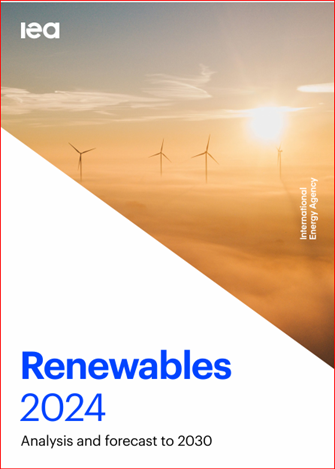Renewables on the Rise
International Energy Agency’s recent report on “Renewables 2024: Analysis and Forecast to 2030” makes an interesting reading and encouraging forecast [1]. The main highlights of the report, extracted from its Executive Summary, are given below for wider dissemination. These highlights provide insights into broad trends up to 2030 in this sector.
- The world is set to add more than 5500 gigawatts (GW) of new renewable energy capacity between 2024 and 2030 – almost three times the increase seen between 2017 and 2023
- China is set to account for almost 60% of all renewable capacity installed worldwide between now and 2030
- Solar PV alone is forecast to account for a massive 80% of the growth in global renewable capacity between now and 2030
- Wind sector is also expected to expand, doubling capacity between 2024 and 2030, compared with the period between 2017 and 2023

- Nearly 70 countries that collectively account for 80% of global renewable power capacity are poised to reach or surpass their current renewable ambitions for 2030.
- The report forecasts global renewable capacity will reach 2.7 times its 2022 level by 2030. This is remarkable; yet it falls short of tripling the capacity by 2030 as envisaged in the Paris Agreement
- Renewables are on course to generate almost half of global electricity by 2030, with the share of wind and solar PV doubling to 30%, according to the forecast.
- The report points out that meeting international climate goals would require not only accelerating the rollout of renewable power, but also significantly speeding up the adoption of sustainable biofuels, biogases, hydrogen and e-fuels.
With regards to India the report states that the country is expected to almost triple its 2022 renewable capacity by 2030, in line with the COP28 global tripling pledge. “Adding 350 GW over 2024-2030, more than triple the previous six-year period, it will maintain third place among the largest renewable energy markets” the report states. (see page 44 of the IEA report [1]).
The report further states that this year, a 40% share of capacity was awarded by India to hybrid systems, which combine PV, wind and storage technologies to reduce generation variability and facilitate system integration. India is a pioneer in supporting hybrid plants, providing a positive example for countries aiming to minimise VRE impacts on power system operations.
The report finally states “Rapid auction expansion, the introduction of a new support scheme for rooftop PV and stronger financial indicators for many utility companies have led us to revise this year’s forecast upwards 22% from last year. India is also in the process of organising its inaugural auctions for offshore wind farms, with the first projects expected to come online after 2030. Continuous policy support and greater project and forecast to 2030 development activity are expected to put India on track to meet its national target of 500 GW of non-fossil-based capacity by 2030.”
References
- Renewables 2024: Analysis and Forecast to 2030, International Energy Agency, www.iea.org/

